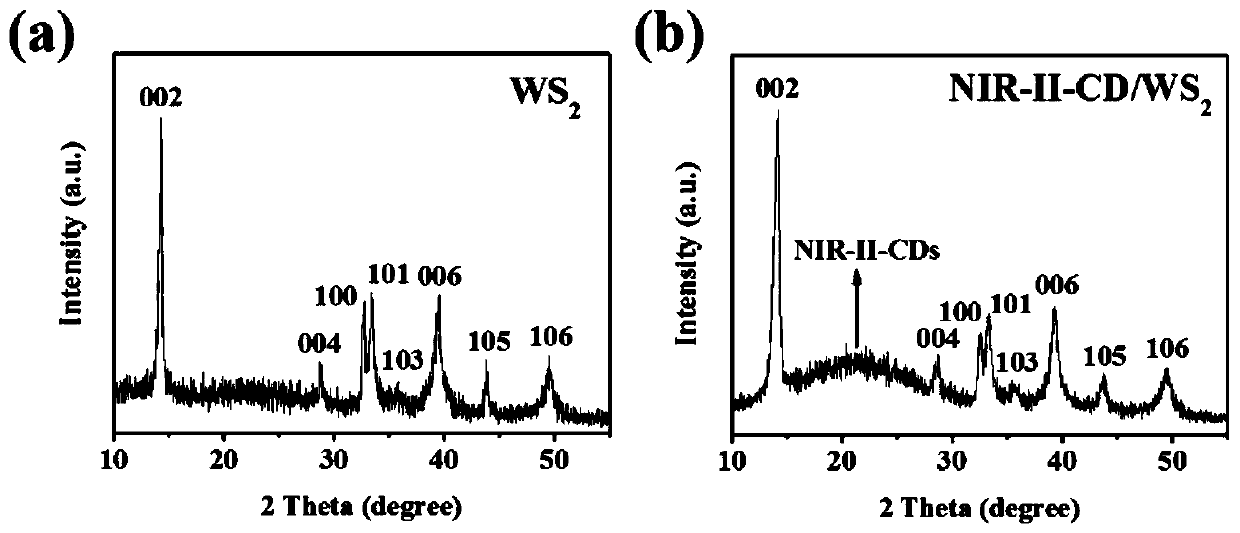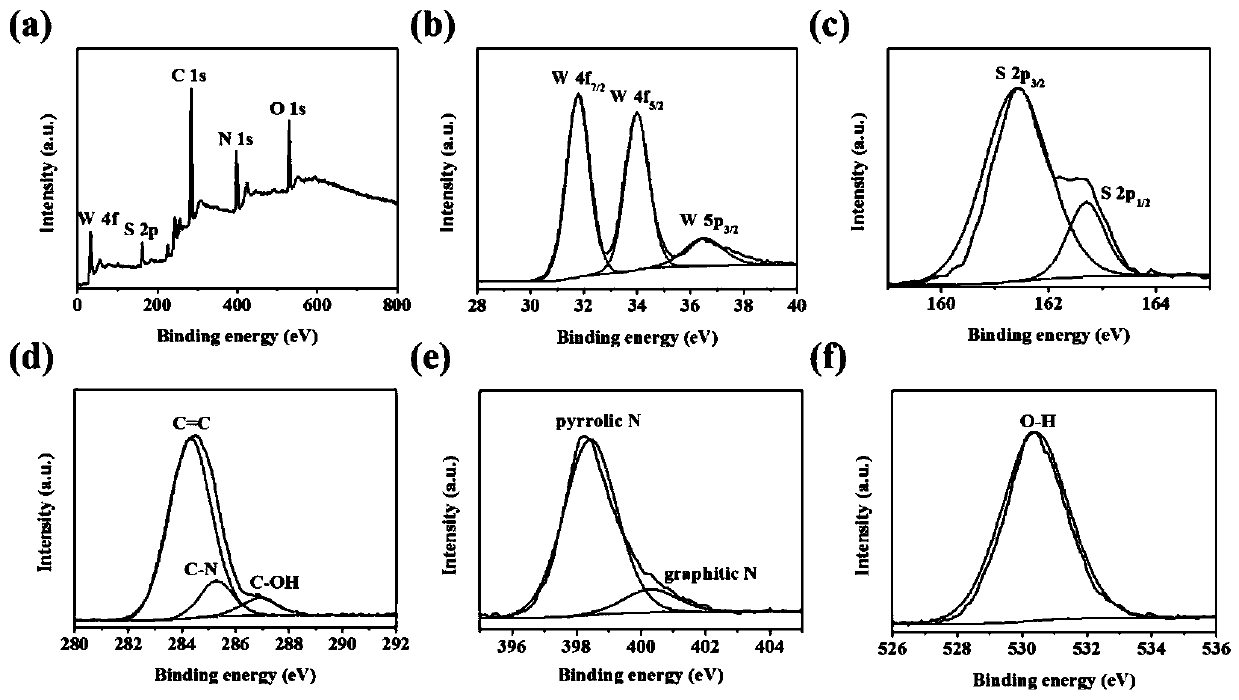Heterojunction photo-thermal agent and preparing method and application thereof
A photothermal reagent and heterojunction technology, applied in pharmaceutical formulations, medical preparations containing active ingredients, bone diseases, etc., can solve the problems of limited PTT application, high laser irradiation power density, low photothermal conversion efficiency, etc. To achieve the effect of good induction of osteogenic differentiation of mesenchymal stem cells, simple preparation process and high biocompatibility
- Summary
- Abstract
- Description
- Claims
- Application Information
AI Technical Summary
Problems solved by technology
Method used
Image
Examples
Embodiment 1
[0048] A method for preparing a heterojunction photothermal reagent, specifically comprising the following steps:
[0049] (1) The method for preparing tungsten sulfide nanosheets:
[0050] S11. Take 200mg of tungsten sulfide powder and place it in a grinder for grinding for 2 hours at a speed of 400r / min, then take 40mg of ball-milled tungsten sulfide powder and disperse it in 40mL of sulfuric acid, and react at 90°C for 24 hours;
[0051] S12, the prepared product is collected by centrifugation at 8000r / min and washed several times with deionized water to remove residual H 2 SO 4 , and finally disperse the product collected by centrifugation into 40mL deionized water and sonicate for 2h;
[0052] S13. Finally, centrifuge the dispersion at 8000r / min to collect the tungsten sulfide nanosheets, disperse them in 20mL deionized water, and set aside;
[0053] (2) Preparation of graphene quantum dots responding in the second near-infrared region:
[0054] S21. Add 0.025mg of 1,...
Embodiment 2
[0062] (1) In vitro CT imaging of graphene quantum dots / tungsten sulfide heterojunction:
[0063] For in vitro CT imaging, the graphene quantum dots / tungsten sulfide heterojunction was diluted to different concentrations (0, 0.625, 1.25, 2.5, 5, 10 mg mL -1 ) into a 0.5mL centrifuge tube for CT imaging ( Figure 6 a).
[0064] (2) In vivo CT imaging of graphene quantum dots / tungsten sulfide heterojunction:
[0065] For in vivo CT imaging, establish an osteosarcoma (MG-63) tumor-bearing mouse model until the tumor volume reaches 500mm 3 When left or right, inject 200 μL of 1.0 mg mL intravenously into mice -1 The graphene quantum dot / tungsten sulfide heterojunction dispersion liquid was taken at 0h and 24h respectively to observe the CT imaging effect of the mouse tumor site ( Figure 6 c).
Embodiment 3
[0067] (1) In vitro photothermal properties of graphene quantum dots / tungsten sulfide heterojunction:
[0068] Dilute the graphene quantum dots / tungsten sulfide heterojunction to different concentrations (0, 0.3, 0.4, 0.5, 0.6mg mL -1 ), then transfer 1.0mL of the solution to a 1.5mL centrifuge tube, and use 808nm and 1064nm lasers at 0.2W cm -2 and 0.6W cm -2 The power density was irradiated for 5 minutes, and deionized water was used as a control group, and the temperature change was recorded with an infrared thermal imager every 30s ( Figure 4 ).
[0069] (2) In vivo photothermal therapy performance evaluation of graphene quantum dots / tungsten sulfide heterojunction:
[0070] Subcutaneously implant 100 μL (1 million) osteosarcoma cells (MG-63) in the armpits of 3-5-week-old female nude mice until the tumor volume grows to 100 mm 3 , the nude mice were divided into 5 groups (5 in each group): (1) normal saline, (2) graphene quantum dots / tungsten sulfide heterojunction, ...
PUM
| Property | Measurement | Unit |
|---|---|---|
| Aperture | aaaaa | aaaaa |
| The average particle size | aaaaa | aaaaa |
Abstract
Description
Claims
Application Information
 Login to View More
Login to View More - R&D
- Intellectual Property
- Life Sciences
- Materials
- Tech Scout
- Unparalleled Data Quality
- Higher Quality Content
- 60% Fewer Hallucinations
Browse by: Latest US Patents, China's latest patents, Technical Efficacy Thesaurus, Application Domain, Technology Topic, Popular Technical Reports.
© 2025 PatSnap. All rights reserved.Legal|Privacy policy|Modern Slavery Act Transparency Statement|Sitemap|About US| Contact US: help@patsnap.com



